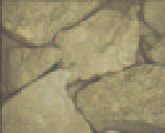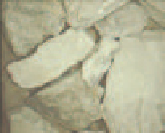Environmental Engineering Reference
In-Depth Information
ROM mixtures. On-line rock composition could be help modify the sorting/blending
strategy for regularizing the grindability of the ROM mixture before feeding the
AG/SAG grinding mills. Furthermore, this information could be used as an input to a
feedfoward controller adjusting the operating conditions of the mill (
e.g.
, throughput
or water addition), and even be used to modify flotation reagent dosage proactively
[81].
3.5.3.1 Mineral Characteristics and Vision System Hardware
About 3000 tons/day of ROM is extracted from an open pit and different under-
ground mines at Raglan (Xstrata Nickel Canada, Inc.). The mine is located in the
Nunavik territory of northern Quebec (Canada). The five mineral types shown in
Figure 3.22 are the most frequently observed in the ROM ore. These are massive
sulphide (MS), disseminated sulphide (DS), “net textured” (NT), gabbro (G), and
peridotite (P). These rocks are highly variable in nickel grade and grindability (
i.e.
crushing or breaking energy) as shown in Table 3.2. Since DS and NT rocks are very
similar in terms of Ni grade and grindability, they are considered as belonging to the
same class in the rock recognition problem (see Table 3.2). Gabbro and P rocks are
also pooled in the same class for similar reasons. Note that, in this particular case,
classifying the rocks according to nickel grade or grindability is the same problem
since high grade rocks are the softest, medium grade have intermediate grindability,
and waste rocks are the hardest. Therefore, the classification results obtained in this
work are equally valid for both properties.
MS
DS
NT
G
P
Figure 3.22
Images of the five different mineral types from Raglan's mine. From Tessier
et al.
[26]
A large quantity of each rock type was obtained from Raglan's mine. These were
sorted by experienced mineralurgists. Rock fragments were 100% -12 inches, but
fines were removed from the analysis. Indeed, the fines are difficult to see on the
conveyor belt.
Images of rocks fragments from individual classes or mixtures were obtained
using a RGB digital camera (JAI CV-M7+) mounted with a 25 mm lens. This cam-










Search WWH ::

Custom Search